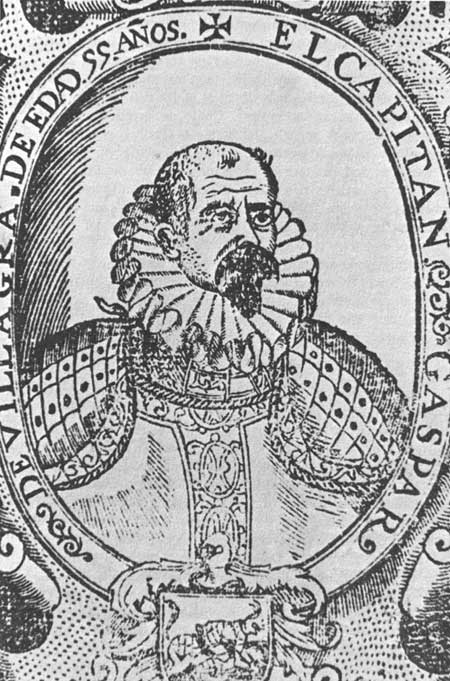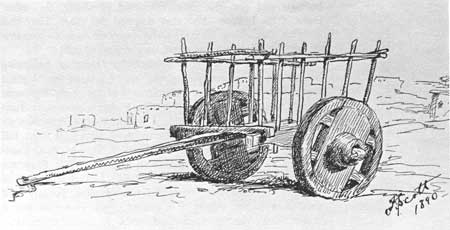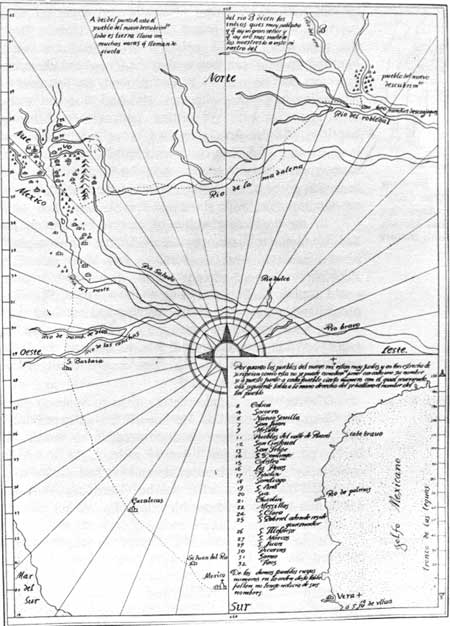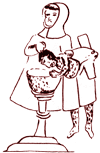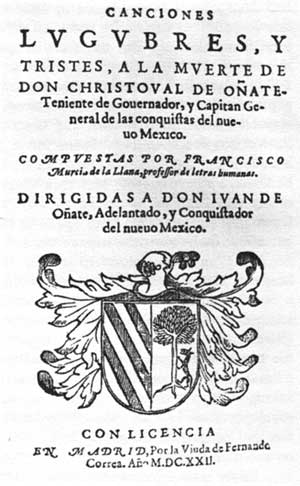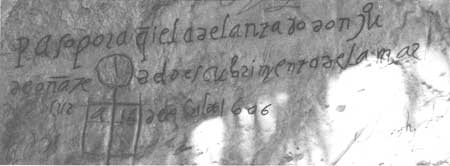

Contents Foreword Preface The Invaders 1540-1542 The New Mexico: Preliminaries to Conquest 1542-1595 Oñate's Disenchantment 1595-1617 The "Christianization" of Pecos 1617-1659 The Shadow of the Inquisition 1659-1680 Their Own Worst Enemies 1680-1704 Pecos and the Friars 1704-1794 Pecos, the Plains, and the Provincias Internas 1704-1794 Toward Extinction 1794-1840 Epilogue Abbreviations Notes Bibliography |
Oñate Appeals for Help The next serious threat to Oñate's rule came not from rebellious Pueblo Indians, but from his own hungry, disillusioned colonists. For two long years they prospected in all directions for the rich lodes that would make New Mexico another Zacatecas, while all the time their families endured a mean existence dependent on what tribute of maize and blankets they could exact from sullen Indians. Oñate professed excitement over meager assay reports. In hopes of further government support, he wrote to viceroy and king describing the expanse of the new land, its tens of thousands of town-dwelling vassals, the potentially rich silver mines and South Sea pearl fisheries, the salines, and the fertile soil. On the plains to the east were untold multitudes of Cíbola cattle and great settlements of natives. "It would be an endless story," he avowed, "to attempt to describe in detail each one of the many things that are found there. All I can say is that with God's help I am going to see them all and give to His Majesty more pacified worlds, new and conquered, greater than the good marques [i.e., Cortés] gave him . . . if your lordship but gives me the succor, favor, and aid I expect from such a [generous] hand." [22] In the spring of 1599, Oñate sent this appeal to Mexico City with Fathers Martínez and Salazar, recruiters, and an escort. Among the supporting documentation they carried was the testimony of one Jusepe Gutiérrez, Mexican Indian servant and interpreter, who had entered New Mexico about 1594 with Captain Leyva de Bonilla, the outlaw Oñate was commissioned to apprehend. According to Jusepe, Leyva's party had spent about a year among the Pueblos, most of the time at San Ildefonso. From there they had gone "through the pueblos of the Pecos and Vaquero Indians" far out onto the plains to "the Great Settlement." Soon after, Jusepe's master, Antonio Gutiérrez de Humaña, stabbed Leyva to death with a butcher knife, whereupon half a dozen Indian servants including Jusepe made their escape. He alone, after numerous adventures, had made it back to New Mexico. [23] The Ácoma troubles had sobered the friars. Now they stuck closer to the Rio Grande. Father San Miguel did not go back to Pecos. In the absence of Father Commissary Martínez, he functioned as vice commissary at the colony's sorry "capital." Perhaps to make room for their numerous Ácoma slaves, the Spaniards moved across the river to the larger west-bank Tewa pueblo of Yunqueyunque, renaming it San Gabriel. All rejoiced on Christmas Eve 1600 when the caravan of reinforcements, supplies, and stock—for which Oñate's relative had earlier given bond—trudged into San Gabriel. With them came seven new friars ready and eager to expand the New Mexico apostolate. Still, none of them ventured to live among the Pecos. [24]
New Mexico's first superior, Fray Alonso Martínez, did not return with the new friars. Fray Juan de Escalona, his replacement as commissary, meant to consolidate missionary effort along the Rio Grande, and he assigned his men accordingly. The venerable Father San Miguel moved down to San Ildefonso only ten miles south of the capital. Testifying in October 1601, Capt. Bartolomé Romero told how we had seen "the Tewa Indians at San Ildefonso, where Fray Francisco de San Miguel was guardian and where they have built a church, come to prayers and to work on the convento." [25]
Desertion of the Colonists Still, the colony was bitterly unhappy in 1601. The new settlers may have provided security but they too had to be fed. Prospects of easy wealth faded daily. Oñate, grasping for truth in the reports of Jusepe Gutiérrez, took half the colony's armed men, Vicente de Zaldívar, a couple of friars, more than seven hundred horses and mules, eight carts, and four pieces of artillery, and embarked in late June via Galisteo for the great plains. With the governor gone, talk of desertion surfaced. Only Oñate's iron rule and harsh treatment of previous deserters had kept the majority of colonists from fleeing before this. The suffering of their women and children, the plagues of bedbugs and lice, the unbearable cold of winter, the sullen looks of the Indians—how they despised this place. They had a saying about New Mexico: Ocho meses de invierno y cuatro de infierno! Eight months of winter and four of hell! [26] Even the friars—later accused by Oñate of fomenting mutiny—spoke gloomily of giving up, of leaving for "a place where His Majesty might be informed of the many legitimate causes for taking this step." Unlike Father Commissary Juan de Escalona, who stayed out of it, old Father Francisco de San Miguel, "vice commissary in these provinces with full powers," preached the abandonment of New Mexico. Testifying in the convento at San Gabriel before Lt. Gov. Francisco de Sosa Peñalosa, the disillusioned San Miguel and four of his fellow Franciscans described the grinding poverty and desolation of the colony. To extract every kernel of stored maize, desperate Spaniards had taken to torturing Indians. Drought had parched the milpas. "If we stay any longer, the natives and all of us here will perish of hunger, cold, and nakedness." [27] When Governor Oñate and his explorers reappeared late in November no more than two dozen colonists turned out to greet them. The others had deserted. Treason, averred don Juan as he ordered Zaldívar after them. But they had too great a lead. They had made it to Santa Bárbara, beyond the adelantado's jurisdiction. They did not have to go back. Their bold protest had drawn the attention of the viceroy. The entire New Mexico endeavor would now be reevaluated. Don Juan's luck had not changed.
New Mexico in the Balance All the Franciscans, except Father Commissary Juan de Escalona and the two friars with Oñate, had gone. They had abandoned every mission in New Mexico. Even the governor's confessor, the "saintly old barefoot and naked-poor friar named Fray Francisco de San Miguel, over seventy-four years of age," had willingly joined the exodus. Father Escalona, who had given the others his blessing and had himself written damning indictments of Oñate's rule, remained at San Gabriel to make a point: the Franciscans did not want to give up New Mexico permanently. But because Oñate lacked resources, because he condoned the plunder of the Pueblos, because he oppressed the colony, "we cannot preach the Gospel now, for it is despised by these people on account of our great offenses and the harm we have done them." The friars begged the government to take over the colony. [28]
Just how many persons they had baptized in New Mexico no one seemed to know. They had administered the sacrament to sick Indians in danger of death, and some no doubt had survived. They had baptized some Pueblo children. Because of the uncertainty of the colony's future and because a few baptized Indians ran away, they had confined themselves for the most part to natives in and around the Spaniards' camp. According to several witnesses who had stood as godparents, the friars, just before deserting, had celebrated two general baptisms. At the first, they had brought into the church "a large number of Indian children belonging to the women slaves from Ácoma and many natives in the service of the Spaniards from the pueblos where we reside;" at the second, a number of women servants, both slave and free. In the conflicting welter of reports by Oñate's partisans and his detractors, the matter of Indian baptisms became a pivotal issue. If there were only a few Christians among the Pueblos, and these already in the Spaniards' employ, they could simply be brought along to New Spain. But if, on the other hand, many and diverse natives had received the saving water, how could the crown in conscience withdraw the colony? While government officials, jurists, and theologians debated New Mexico's fate, the Franciscans consigned another six workers to the vineyard. [29] Oñate Resigns The embattled Oñate sent Zaldívar to Spain to plead with the Council of the Indies. He himself led an expedition to the Gulf of California where he discovered, in his words, "a great harbor on the South Sea." But try as he might, the adelantado could not dispel the cloud of doubt that had settled over New Mexico. Finally, in a letter to the viceroy dated August 24, 1607, don Juan poured out his bitter cup and resigned. [30] Baptisms Save the Colony Between 1601 and 1607, estimates of the number of baptized Indians in New Mexico ranged from five dozen to more than six hundred. Viceroy Marqués de Montesclaros, who succeeded Monterrey, had advised the king in 1605 that even "if there should be one lone Christian, Your Majesty would be obliged by justice, conscience, and reputation to preserve him, even at great cost to the royal treasury." Knowing that it would take more than one convert to loosen the royal purse strings, a Franciscan, just returned from New Mexico late in 1608, reported a figure so high that it could only have resulted from truly prodigious evangelical effort, or gross exaggeration—more than seven thousand!
But Fray Lázaro Jiménez knew what he was about. He had first gone to New Mexico in 1603 or 1605 and returned late in 1607 "to beg in the name of all" that the crown either send men, clothing, and livestock, or permission to abandon the colony. If they received no orders to the contrary by June 1608, they would all leave. The king meantime decreed that exploration cease, that Oñate be replaced, but that the colonists stay on until a final decision had been reached. Viceroy Luis de Velasco, back in New Spain for a second term, favored abandonment and the withdrawal of Christian Indians. But he had used Father Jiménez, sent back again to New Mexico with escort and supplies, to advise Oñate and the settlers not to leave until further word from Spain, at last not before December 1609. Only when the friar reached the colony in 1608 had he found out, marvelous to relate, that a couple of his brethren in six months had baptized thousands. [31] Whether fact or fiction, "the more than seven thousand" sudden Pueblo converts saved New Mexico for the friars. Obviously, wrote Velasco to the king, "we could not abandon the land without great offense to God and great risk of losing what has been gained." With unusual dispatch, the viceroy arranged for reinforcements, more supplies, more friars, and a royal governor to take over the colony's administration from the lord proprietor Oñate. By late 1609, the whole outfit was on the road north. [32] Oñate waited impatiently at San Gabriel. By early February 1610, soon after he had received the officious new governor, one don Pedro de Peralta, the undone adelantado took his leave. After all his trouble, after all the past fifteen years of his life, after all the six hundred thousand pesos he and his associates had spent on the New Mexico venture, don Juan de Oñate braced himself not for a hero's welcome but for a trial on criminal charges. Another México, another Cortés, at this point nothing could have been farther from his mind. A Royal Missionary Colony New Mexico plainly was not an asset to anyone but the Franciscans. The decision to convert it from proprietary to royal colony rested not on economic potential, but on Christian obligation. A pious monarch, Philip III could not in conscience turn his back on thousands of baptized Indians. And no one challenged the friars' claim. Neither Luis de Velasco, the well-respected viceroy who had originally given Oñate the contract, nor don Juan himself looked as bad in the light of so rich a harvest of souls. They had made the best of a bad bargain. As for the friars, they now enjoyed an advantage over everyone else in the colony. Because the government had pronounced New Mexico a vineyard of the Lord, they as the Lord's ordained workers were indispensable. Clearly, in their minds, the layman-colonist existed to aid and protect the missionary. The friars appeared to have it all their own way. No rival order competed with them. There was not a single diocesan priest anywhere in New Mexico, which meant that the faithful had no one else to turn to for the sacraments. No bishop exercised effective jurisdiction over the isolated colony. New Mexico had become an ecclesiastical monopoly of the Franciscans. They were the Church. The only check on the friars was the royal governor. As the colony's chief executive, legislator, and judge, as well as commander of the meager military, he wielded a countervailing force as concentrated and as potentially tyrannical as theirs. He and his appointees were the State. The colonist, exhorted by both masters, had often to choose between the two.
| ||||||||||||
 Top Top
|
| ||||||||||||

